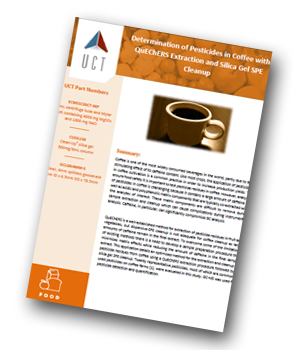UCT has produced an application note detailing an optimized method for the extraction and cleanup of pesticide residues from coffee using a QuEChERS extraction procedure followed by a silica gel SPE cleanup.
 Introduction
Introduction
Coffee is one of the most widely consumed beverages in the world, partly due to the stimulating effect of its caffeine content. Like most crops, the application of pesticides in coffee cultivation is a common practice in order to increase production yields. To ensure food safety it is important to test pesticide residues in coffee. However, analysis of pesticides in coffee is challenging because it contains a large amount of caffeine as well as acidic and polyphenolic matrix components that are typically co-extracted with the analytes of interest.
Experimental
QuEChERS is a well-established method for extraction of pesticide residues in fruit and vegetables, but dispersive-SPE cleanup is not adequate for coffee cleanup as large amounts of caffeine remain in the final extract. To overcome some of the limitations of existing methods there is a need to develop a sample preparation procedure that minimizes matrix effects while reducing the amount of caffeine in the final sample extract. Twenty representative pesticides, most of which are commonly used pesticides on coffee farms, were evaluated in this study. GC-MS was used for pesticide detection and quantification. The QuEChERS procedure is described in detail in the application note.
Conclusion
QuEChERS extraction and silica gel SPE cleanup are shown to be an effective means of pesticide determination in coffee.




